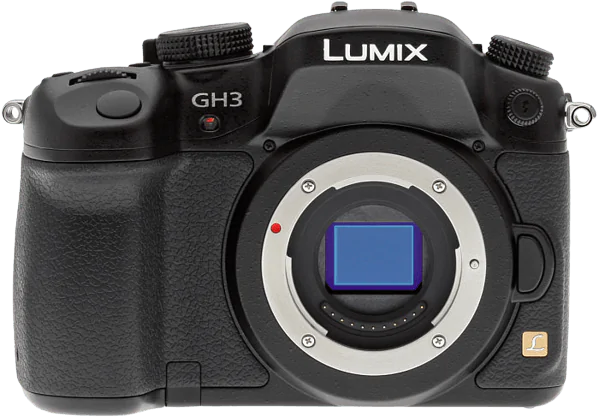Panasonic Lumix DMC-GH3 Specs and Scores

The Panasonic Lumix DMC-GH3 receives a score of 53/100 in our evaluation. This mirrorless camera was announced on September 17, 2012, and released the same year with a launch price of $1300. The camera measures 133 x 93 x 82mm and weighs 550g, or 1.21lbs.
Considering its age, the GH3 has decent specifications, but it may not stand out in today’s competitive market. With newer models offering advanced features, the GH3’s score of 53/100 reflects its position among other cameras in the industry.
Panasonic Lumix DMC-GH3 Overview and Optics
The optics of the Panasonic Lumix DMC-GH3 receive a score of 50 out of 100. The camera features a 16.05-megapixel CMOS sensor, a Venus Engine VII FHD processor, and a Micro Four Thirds lens mount. With a shooting speed of 20 frames per second, this camera ranks average in today’s market. The DXOMARK score for the sensor is 71, which is decent but not top-notch.
The camera lacks image stabilization, which is a drawback considering many competitors have this feature. The 4:3 aspect ratio is common among cameras in this category, so it doesn’t stand out in this regard.
The Panasonic Lumix DMC-GH3 has adequate optics, but it doesn’t excel in any particular aspect. It’s a suitable choice for those seeking a decent camera, but there are better options available for those who prioritize exceptional optics.
Panasonic Lumix DMC-GH3 Video Performance
The Panasonic Lumix DMC-GH3 has a video score of 70/100. Its maximum video resolution is Full HD with dimensions of 1920 x 1080 pixels, allowing for clear and sharp recordings. The camera supports a maximum video frame rate of 60fps, ensuring smooth motion capture in high-action scenes.
In today’s market, the GH3’s video capabilities remain competitive, but newer models often offer higher resolutions such as 4K. However, the GH3 stands out with its built-in time-lapse functionality, providing users with creative options for capturing dynamic scenes over extended periods.
Considering its features and performance, the Panasonic Lumix DMC-GH3 offers solid video capabilities for enthusiasts and professionals alike. While it may not have the highest resolution available, its Full HD quality, smooth frame rate, and time-lapse functionality make it a reliable choice for capturing high-quality video content.
Panasonic Lumix DMC-GH3 Features and Benefits
The Panasonic Lumix DMC-GH3 receives a feature score of 65/100. This camera comes with a 3-inch touchscreen and a flip screen, making it convenient for various shooting angles. With a screen resolution of 614000 dots, the display provides clear visuals for users. However, it lacks GPS and Bluetooth capabilities, which are common in other modern cameras. The camera does include WIFI, allowing for easy sharing and transfer of images.
Comparing these features to today’s market, the Lumix DMC-GH3 falls short in some aspects. The absence of GPS and Bluetooth can limit its functionality for certain users. However, its touchscreen, flip screen, and WIFI connectivity make it a viable option for those who prioritize those aspects. The Lumix DMC-GH3 may not be the most feature-packed camera available, but it still offers valuable functions for photographers and videographers.
Panasonic Lumix DMC-GH3 Storage and Battery
The Panasonic Lumix DMC-GH3 receives a storage and battery score of 27/100. With only one memory card slot, the camera accepts SD, SDHC, and SDXC cards. It has a battery life of 540 shots, which is powered by a Li-ion 1600 mAh battery. However, the camera lacks USB charging capabilities.
In today’s market, the GH3’s storage and battery specifications fall short compared to newer models. The single memory card slot and absence of USB charging may limit its appeal for professionals and enthusiasts who require more flexibility and convenience in these aspects.
Despite its low score in this area, the Panasonic Lumix DMC-GH3 remains a capable camera for those who can work within its storage and battery limitations.
